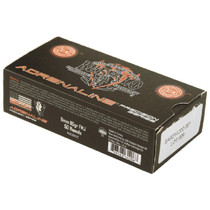Optics 101: MIL vs. MOA
Posted by Cory Ross on Jan 21st 2022

Introduction:
Optics 101 takes readers on the journey of understanding the ins and outs of riflescopes. Of any area in the gun world, optics may have advanced the most over the past two decades. With the proliferation of PRS (precision rifle series), long-range hunting, and new, more capable cartridges, the shooter has required more out of their optic. Today using riflescopes requires more of crash course than in previous decades. This series is designed to help the user get the most out of their optic and system.
The Basics
Before diving into the details of riflescopes, a few basic pieces of information need to be laid out. To start, a scope has three optical systems that need to be defined. First, the objective is the portion of a scope forward of the turrets. Second, the erector is the system forward of the eyepiece to the turrets. Finally, is the eyepiece itself. In each optical system are series of lenses that directs the image back to the human eye.
Another common term used in optics is aberration. This needs to be defined in order to better understand how light transmits. Aberration is the failure of light rays to converge at one focus point because of limitations or defects in a lens . Essentially, when light hits the first lens of a riflescope, the light begins to bend and refract in undesirable ways. A good scope uses tools to fix the aberration in order to create a clear and bright target picture.
Finally, focal plane. The reticle of an optic can be placed in two different focal planes—one forward of the turret assembly and one rearward. A reticle in the rear focal plane (called second focal) maintains a constant size while moving up and down the magnification range. Front focal—or more accurately called first focal plane—optics have reticles that increase and decrease in size proportionally as the magnification is increased and decreased. The importance of understanding the difference is the intended application, which will be discussed in a future Optics 101.
Units of Measure
The main focus of this Optics 101 article is the units of measure scopes use. The two main types can be used effectively as long as the user understands them and can articulate that understanding in the field. There are a lot of myths surrounding the two units of measure, however, this section looks to define them so that the reader can choose the best one for themselves.
To start, most users have experience with optics that use 1/4” at 100 yard adjustments, known as MOA (minute of angle). However milliradians (MILs), which are usually divided into 1/10 increments, are increasing in popularity. In simple terms, MOA and MILS are two different ways to divide a circle.
MOA
A circle is 360 degrees with each degree divided into 60 minutes. Therefore, each circle is made up of 21,600 minutes. At a hundred yards, 1 degree measures 62.83 inches. One MOA then—1/60 of that—is 1.047 inches. Normally, MOA is rounded down to an even 1 inch. For most shooting, using the approximation is fine. For example, at 1000 yards 1 MOA is approximately 10 inches. The exact is 10.47 inches—a negligible difference.

MILs
A common misunderstanding involving MILs is that it is a metric only system. This is not completely true. A radian itself is a metric form of angular measure dividing radians in a circle. Conversely, milli means 1/1000, so 1 milliradian is 1/1000 of a radian. Additionally, one radian is equal to 57.3 degrees—360 degrees divided by 57.3 equals 6.2832 MILs in a circle. There are 1,000 MILs in 1 radian and 6,2382 MILs in a circle. MILs are then divided into tenths for precise measurement. At 100 hundred yards 1 MIL is 3.6” and .1 MIL is .36”. At 100 meters 1 MIL is 10 centimeters and .1 MIL is 1 centimeter. 1 MIL at a thousand yards then equals one yard and 1 MIL at a thousand meters equals one meter. MILs maybe a metric unit of measure, but the systems works with both standard and metric units of measure.

Application
MOA is still the most common measurement system used, but MILs are quickly gaining ground as more and more shooters engage in long-range shooting. Originally, MILs were used to offer quick, on the fly range estimation. Essentially, if the shooter knows the approximate size of a target downrange, they can use a MIL based reticle to measure the height of the target. Then that information is input into the formula Range = size of target / MILs. With the advancement of ballistic calculators, individuals can use that information in conjunction with their reticle to hold over elevation at different ranges. If the elevation drop is 2.7 MILs, the shooter can either dial it or hold 2.7 MILs in the reticle. The same can be done with MOA, however, with MILs being divided into tenths, MILs can be faster—but that is largely subjective.
Conclusion
The first in a series of articles discussing optics, MOA vs MIL was designed to educate the reader and user on the understanding of the two different measuring systems. The next article will take the information above and discuss how MOA and MILs are used in reticles that offer a wide range of applications.










